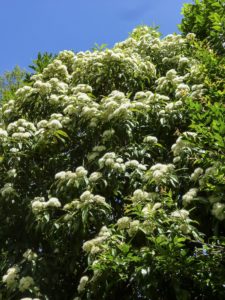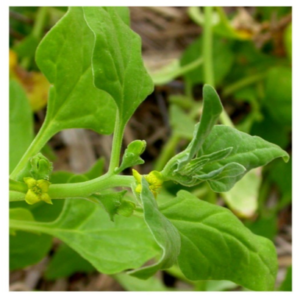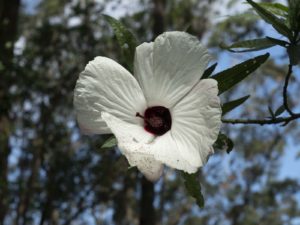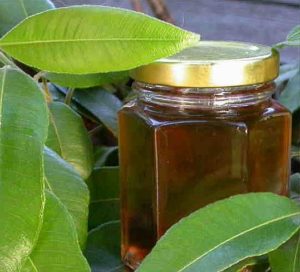Here are some wonderful recipes for bush foods, developed by Colleen and Geoff.
Just a word of warning first: Be sure plants are accurately identified. Exercise caution with unfamiliar foods. Although the following are usually considered safe, adverse reactions in particular individuals cannot be ruled out.
Lemon Myrtle drink: Backhousia citriodora

To make 2 litres of lemon myrtle drink, take 4 fresh young lemon myrtle leaves. Pour over a small quantity of boiling water. Let cool. Add cooled liquid to a 2 litre bottle of cold water. The flavour keeps coming from leaves for several days so further drinks can be made by adding fresh water to the leaves.
Lemon Myrtle syrup: Backhousia citriodora
5 grams of lemon myrtle leaves; 1 1/4 cups of boiling water’ 1 1/4 cups of sugar
Roughly chop lemon myrtle leaves. Pour over boiling water. When mixture has cooled, discard leaves and mix the water and sugar together. Bring mixture to the boil. Lower heat and simmer gently until the volume is reduced by a third. Pour into a sterilised jar and store in the fridge.
Tetragonia tetragonioides, Warrigal Greens

IMPORTANT: Warrigal Greens have a high oxalate concentration. Blanch leaves in boiling water for several minutes. Discard water. Rinse leaves before using.
Warrigal Greens Pie (rice base)
Delicious both hot and cold. Garnish with lemon myrtle leaves.
Rice (extra tasty if rice is cooked in coconut cream)
Greased dish, e.g. oval dish 27 cm x 19 cm and 5 cm deep.
4 eggs, beaten with 1/2 cup milk (can be low fat milk)
Grated cheese (can be low fat)
Blanched Warrigal Green leaves
Put a layer of rice into the bottom of the dish, patting down firmly until layer is about 2 cm thick.
Cover rice with a thick layer of grated cheese. Place a layer of blanched Warrigal Greens so cheese is completely covered. Pour over the eggs beaten with milk. Add another layer of grated cheese to finish off. Microwave for 5 minutes on high and 10 minutes on medium.
Hibiscus heterophyllus, Australian native hibiscus recipes

This native hibiscus, which occurs along the eastern coast of Australia in New South Wales & Queensland, is in the same group of plants as Hibiscus sabdariffa (Rosella). The petals of Hibiscus heterophyllus can be used to make jam, syrup and cordial. The flavour of the flowers & buds is very mild. Flowers only last one day but if they are to be used at night, they can be picked as they begin to unfurl in the morning, then stored in the refrigerator crisper and if taken out in the late afternoon, will open and stay fresh until well into the evening. The flowers make a colourful edible ornament for a salad. Buds can be pickled or boiled as a vegetable; flowers can be stuffed, made into fritters or tea.
For the following recipes, use Hibiscus heterophyllus or some of its crosses, e.g. ‘Montburg Pink’, ‘Ian’s Cream’, ‘Citrus Haze’, ‘Citrus Mist’, ‘Tasty White’. Buds can be picked over 2-3 days & stored in fridge until required.
Microwave Method: Times based on 600 watts on high. Adjust times as needed according to Microwave.
Petals only from 10 large hibiscus flowers
1/4 cup of lemon juice
Detach petals from calyx and discard calyx. Chop petals finely & place in a very deep pyrex bowl.
Cover petals with lemon juice.
Australian Native Hibiscus Preserve: As above plus:
1/2 cup of boiling water; 2 cups of sugar
Microwave petals and lemon juice on high for 4 minutes. Add boiling water & sugar & stir well. Cook 2 minutes then stir. Cook another 2 minutes, stir & then cook 2 minutes more and stir. Let cool for one hour. When cool, cook for 2 minutes then stir. Test whether preserve gels by placing a small amount on a cold plate. If needed, continue cooking but no more than 2 minutes at a time. Pour into a sterilised jar. This recipe produces a rich red spread with the consistency of honey. It has a distinctive flavour and is delicious on toast or scones. Can be used as a glaze or diluted with white vinegar for sauces or marinades.
Australian Native Hibiscus Syrup: As above plus:

1 cup of boiling water; 1 cup of sugar
Microwave petals and lemon juice on high for 2 minutes. Place the water & sugar into a heavy-based saucepan and heat until sugar has dissolved. Add petals & lemon juice. Bring mix to the boil. Lower heat and simmer gently until the volume is reduced by a third (about an hour). Remove from heat & strain through a fine sieve to remove petals. Pour into a sterilised jar. Syrup will keep for 12 months if refrigerated.
Australian Native Hibiscus Cordial: As above plus:
1/2 cup of boiling water; ½ cup of sugar
Microwave petals and lemon juice on high for 2 minutes. Dissolve sugar in boiling water. Add petals and lemon juice. Place in a 2 litre bottle and fill with cold water and ice. Stir well before drinking.
Honey Joys
125g butter (1/2 a small packet of butter); 1/2 cup caster sugar; 2 tablespoons honey; 4 cups cornflakes
In a frying pan (electric is easier), melt butter, sugar and honey together over medium heat. Boil for three minutes, stirring continuously. Remove from heat and pour over cereal. Put 1-2 tablespoons into separate patty pans (about 20). Leave in refrigerator until cool enough to eat. Glaze with heated Hibiscus Preserve.
For more information, contact Colleen or Geoff at www.hibiscus.org.
